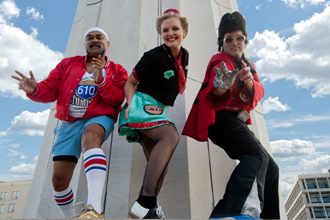These krewes walk on the wild side at Carnival
In 1837, a Times-Picayune reporter noted that the first documented Mardi Gras walking parade “excited considerable speculation as to who they were, what were their motives, and what upon earth could induce them to turn out in such grotesque and outlandish habiliments.” Some things never change. While Carnival in New Orleans has grown and evolved, today's highly stylized and satirical walking krewes maintain the tradition of celebration and parody as well as philanthropy.

Dressed for parade performances are, from left, 610 Stomper Dorian-gray Alexander, Muff-a-lotta Kristin Condotta and Rolling Elvi member Scott Galante. (Photo by Sally Asher)
A Ph.D. candidate in the Tulane Department of History, Kristin Condotta also is a fan of nostalgia, which attracted her to the female dance krewe, the Muff-a-lottas. A cheeky spin on the classic New Orleans Italian sandwich, women dress as waitresses and “capture the sultriness of the 50s-era song, wherein you get little teasings of 'ill behavior' but nothing directly suggested.” This, Condotta says, makes the Muff-a-lottas “fun for kids, adults and my grandma!”
When the music is off, Dorian-gray Alexander is a standardized patient trainer at the Tulane School of Medicine, but when the music is on, this “ordinary man with extraordinary moves” is a member of the 610 Stompers. Known for their short shorts and knee-highs, this male dance krewe has gained national exposure. Alexander says Stomper requirements are basic: “uninhibited desire to dance, flirty gyrations and magnum moustaches (if possible).&#x#x201d;
These krewe members also volunteer for such charities as Bridge House, NO/AIDS TAsk Force and the Louisiana SPCA.
Whether it's women in poodle skirts or men in gym shorts or giant pompadours, it's this mix of flair, irreverence and fellowship that continues to make New Orleans magical.
